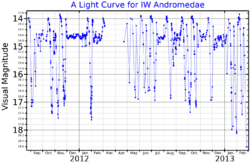Astronomy:IW Andromedae
| Observation data Equinox J2000.0]] (ICRS) | |
|---|---|
| Constellation | Andromeda |
| Right ascension | 01h 01m 08.907s[2] |
| Declination | 43° 23′ 25.79″[2] |
| Apparent magnitude (V) | 13.7 to 17.3[3] |
| Characteristics | |
| Spectral type | sdOB[4] |
| Variable type | Z Cam(?)[3] |
| Astrometry | |
| Proper motion (μ) | RA: +2.471[2] mas/yr Dec.: −5.904[2] mas/yr |
| Parallax (π) | 1.1413 ± 0.0326[2] mas |
| Distance | 2,860 ± 80 ly (880 ± 30 pc) |
| Details | |
| White dwarf | |
| Mass | 0.75[5] M☉ |
| Radius | 0.015[5] R☉ |
| Temperature | 25,000[5] K |
| Donor star | |
| Mass | 0.27[5] M☉ |
| Other designations | |
| Database references | |
| SIMBAD | data |
IW Andromedae is a binary star system in the northern constellation of Andromeda, abbreviated IW And. It is the prototype of a class of variable stars known as IW And variables, which is an anomalous sub-class of the Z Camelopardalis (Z Cam) variables.[7] The brightness of this system ranges from an apparent visual magnitude of 13.7 down to 17.3,[3] which requires a telescope to view. The system is located at a distance of approximately 2,860 light years from the Sun based on parallax measurements.[2]
The irregular variability of this star was discovered by L. Meinunger in 1975.[8][9] The spectra was found to resemble a blue–hued OB star with some peculiarities. It is a confirmed cataclysmic variable (CV) but its properties differ markedly from other sub-classes of that type.[10] The photometric behavior of the star is dissimilar to that of a dwarf or polar nova as it shows rapid brightening of up to three magnitudes in periods of around a day,[11] but stays in a low excitement state about 72% of the time.[10] Evidence for weak emission of the hydrogen–alpha line was discovered by W. Liu and associates in 1999.[9]
This is a close binary system with an orbital period of 223 minutes (3.7 hours). The primary component is a white dwarf star with 75% of the mass of the Sun. The secondary component has 27% of the Sun's mass and is overflowing its Roche lobe, resulting in mass transfer to an accretion disk orbiting the primary. The accretion rate for the primary is 3×10−9 M☉·yr−1.[5]
T. Kato and associates in 2003 found the light curve matched a Z Cam variable, with the previously observed inactive states being caused by a characteristic standstill. The duty cycle of its standstill is unusually long for a variable of this class.[10] Outbursts during these standstills may be explained by flares on the secondary, which result in brief surges in mass transfer.[12]
Other variables displaying IW And–type behavior have since been discovered, including HO Puppis,[13] BC Cassiopeiae,[14] IM Eridani, V507 Cygni, and FY Vulpecula.[7]
References
- ↑ Download Data, AAVSO, https://www.aavso.org/data-download, retrieved 9 April 2023.
- ↑ 2.0 2.1 2.2 2.3 2.4 Brown, A. G. A. (2021). "Gaia Early Data Release 3: Summary of the contents and survey properties". Astronomy & Astrophysics 649: A1. doi:10.1051/0004-6361/202039657. Bibcode: 2021A&A...649A...1G. Gaia EDR3 record for this source at VizieR.
- ↑ 3.0 3.1 3.2 Samus, N. N. et al. (2017), "General Catalogue of Variable Stars", Astronomy Reports, 5.1 61 (1): 80–88, doi:10.1134/S1063772917010085, Bibcode: 2017ARep...61...80S.
- ↑ Meinunger, L. (May 1980), "Spectra of Four Blue Irregular Variables in Andromeda", Information Bulletin on Variable Stars 1795: 1, Bibcode: 1980IBVS.1795....1M.
- ↑ 5.0 5.1 5.2 5.3 5.4 Szkody, Paula et al. (December 2013), "A Study of the Unusual Z Cam Systems IW Andromedae and V513 Cassiopeia", Publications of the Astronomical Society of the Pacific 125 (934): 1421–1428, doi:10.1086/674170, Bibcode: 2013PASP..125.1421S.
- ↑ "IW ANd". SIMBAD. Centre de données astronomiques de Strasbourg. http://simbad.u-strasbg.fr/simbad/sim-basic?Ident=IW+ANd.
- ↑ 7.0 7.1 Kato, Taichi (January 2019), "Three Z Camelopardalis-type dwarf novae exhibiting IW Andromedae-type phenomenon", Publications of the Astronomical Society of Japan 71 (1): 20, doi:10.1093/pasj/psy138, 20, Bibcode: 2019PASJ...71...20K.
- ↑ Meinunger, L. (1975), "Veränderliche in einem Feld um ν Andromedae", Mitteilungen über Veränderliche Sterne 7: 1–21, Bibcode: 1975MitVS...7....1M.
- ↑ 9.0 9.1 Liu, Wu et al. (May 1999), "Spectroscopic Confirmation of 55 Northern and Equatorial Cataclysmic Variables. I. 27 Confirmed Cataclysmic Variables", The Astrophysical Journal Supplement Series 122 (1): 243–255, doi:10.1086/313210, Bibcode: 1999ApJS..122..243L.
- ↑ 10.0 10.1 10.2 Kato, Taichi et al. (February 2003), "IW And is a Z Cam-Type Dwarf Nova", Information Bulletin on Variable Stars 5376: 1, Bibcode: 2003IBVS.5376....1K.
- ↑ Meinunger, L.; Andronov, I. L. (September 1987), "Photometric Study of the Blue Variables IW, IZ and IO Andromedae", Information Bulletin on Variable Stars 3081: 1, Bibcode: 1987IBVS.3081....1M.
- ↑ Hameury, J. -M.; Lasota, J. -P. (September 2014), "Anomalous Z Cam stars: a response to mass-transfer outbursts", Astronomy & Astrophysics 569: A48, doi:10.1051/0004-6361/201424535, A48, Bibcode: 2014A&A...569A..48H.
- ↑ Lee, Chien-De et al. (April 2021), "HO Puppis: Not a Be Star, but a Newly Confirmed IW And-type Star", The Astrophysical Journal 911 (1): 51, doi:10.3847/1538-4357/abe871, 51, Bibcode: 2021ApJ...911...51L.
- ↑ Kato, Taichi; Kojiguchi, Naoto (December 2020), "BC Cassiopeiae: First detection of IW Andromedae-type phenomenon among post-eruption novae", Publications of the Astronomical Society of Japan 72 (6): 98, doi:10.1093/pasj/psaa096, 98, Bibcode: 2020PASJ...72...98K.
 |


